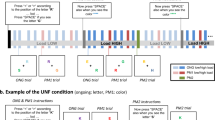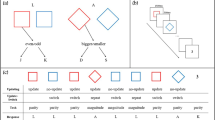Abstract
One common assumption has been that prefrontal executive control is mostly required for target detection (Posner and Petersen in Ann Rev Neurosci 13:25–42, 1990). Alternatively, cognitive control has also been related to anticipatory updating of task-set (contextual) information, a view that highlights proactive control processes. Frontoparietal cortical networks contribute to both proactive control and reactive target detection, although their fast dynamics are still largely unexplored. To examine this, we analyzed rapid magnetoencephalographic (MEG) source activations elicited by task cues and target cards in a task-cueing analogue of the Wisconsin Card Sorting Test. A single-task (color sorting) condition with equivalent perceptual and motor demands was used as a control. Our results revealed fast, transient and largely switch-specific MEG activations across frontoparietal and cingulo-opercular regions in anticipation of target cards, including (1) early (100–200 ms) cue-locked MEG signals at visual, temporo-parietal and prefrontal cortices of the right hemisphere (i.e., calcarine sulcus, precuneus, inferior frontal gyrus, anterior insula and supramarginal gyrus); and (2) later cue-locked MEG signals at the right anterior and posterior insula (200–300 ms) and the left temporo-parietal junction (300–500 ms). In all cases larger MEG signal intensity was observed in switch relative to repeat cueing conditions. Finally, behavioral restart costs and test scores of working memory capacity (forward digit span) correlated with cue-locked MEG activations at key nodes of the frontoparietal network. Together, our findings suggest that proactive cognitive control of task rule updating can be fast and transiently implemented within less than a second and in anticipation of target detection.



Similar content being viewed by others
Notes
Switch-specific and transient (200–300 ms post-cue) MEG activations did reach significance in the ACC bilaterally when using a less strict double-threshold approach combining voxel-based with minimum cluster size (cf., Stelzel et al. 2011).
Even using a less strict double-threshold approach (Stelzel et al. 2011), only one task-level contrast (repeat > standard) reached significance for MEG activations at the middle frontal gyrus 300–400 post-target onset.
References
Adrover-Roig D, Barceló F (2010) Individual differences in aging and cognitive control modulate the neural indexes of context updating and maintenance during task switching. Cortex 46:434–450
Allport A, Wylie G (2000) Task-switching, stimulus-response bindings and negative priming. In: Monsell S, Driver J (eds) Control of cognitive processes: attention and performance XVIII. MIT Press, Cambridge, pp 35–70
Altmann EM (2007) Comparing switch costs: alternating runs and explicit cuing. J Exp Psychol 33(3):475–483
Altmann EM, Gray WD (2008) An integrated model of cognitive control in task switching. Psychol Rev 115(3):602–639
Barber AD, Carter CS (2005) Cognitive control involved in overcoming prepotent response tendencies and switching between tasks. Cereb Cortex 15:899–912
Barceló F (2003) The Madrid card sorting test (MCST): a task switching paradigm to study executive attention with event-related potentials. Brain Res Protoc 11:27–37
Barceló F, Cooper PS (in press) An information theory account of late frontoparietal ERP positivities in cognitive control. Psychophysiology, in press
Barceló F, Knight RT (2007) An information-theoretical approach to contextual processing in the human brain: evidence from prefrontal lesions. Cereb Cortex 17(Suppl 1):i51-60
Barceló F, Suwazono S, Knight RT (2000) Prefrontal modulation of visual processing in humans. Nat Neurosci 3:399–403
Barceló F, Escera C, Corral MJ, Periáñez JA (2006) Task switching and novelty processing activate a common neural network for cognitive control. J Cogn Neurosci 18:1734–1748
Barceló F, Perianez JA, Nyhus E (2008) An information theoretical approach to task-switching: evidence from cognitive brain potentials in humans. Front Hum Neurosci 1:13. https://doi.org/10.3389/neuro.09.013.2007
Bayless SJ, Gaetz WC, Cheyne DO, Taylor MJ (2006) Spatiotemporal analysis of feedback processing during a card sorting task using spatially filtered MEG. Neurosci Lett 410:31 – 6
Benjamini Y, Hochberg Y (1995) Controlling the false Discovery rate: a practical and powerful approach to multiple testing. J R Stat Soc 57:289–300
Braver TS (2012) The variable nature of cognitive control: a dual mechanisms framework. Trends Cogn Sci 16:106 – 13
Braver TS, Barch DM (2002) A theory of cognitive control, aging cognition, and neuromodulation. Neurosci Biobehav Rev 26:809 – 17
Braver TS, Reynolds JR, Donaldson DI (2003) Neural mechanisms of transient and sustained cognitive control during task switching. Neuron 39:713 – 26
Collins DL, Zijdenbos AP, Kollokian V, Sled JG, Kabani NJ, Holmes CJ, Evans AC (1998) Design and construction of a realistic digital brain phantom. IEEE Trans Med Imaging 17:463–468
Corbetta M, Shulman GL (2002) Control of goal-directed and stimulus-driven attention in the brain. Nature Reviews in Neuroscience 3(3):201–215
Corbetta M, Patel G, Shulman GL (2008) The reorienting system of the human brain: from environment to theory of mind. Neuron 58(3):306–324
Derrfuss J, Brass M, Neumann J, von Cramon DY (2005) Involvement of the inferior frontal junction in cognitive control: meta-analyses of switching and Stroop studies. Hum Brain Mapp 25:22–34
Dosenbach NU, Visscher KM, Palmer ED, Miezin FM, Wenger KK, Kang HC, Burgund ED, Grimes AL, Schlaggar BL, Petersen SE (2006) A core system for the implementation of task sets. Neuron 50:799–812
Dosenbach NU, Fair DA, Cohen AL, Schlaggar BL, Petersen SE (2008) A dual-networks architecture of top-down control. Trends Cogn Sci 12:99–105
Dreher JC, Berman KF (2002) Fractionating the neural substrate of cognitive control processes. Proc Natl Acad Sci USA 99:14595–14600
Forstmann BU, Brass M, Koch I (2007) Methodological and empirical issues when dissociating cue-related from task-related processes in the explicit task-cuing procedure. Psychol Res 71(4):393–400
Henaff MA, Bayle D, Krolak-Salmon P, Fonlupt P (2010) Cortical dynamics of a self driven choice: a MEG study during a card sorting task. Clin Neurophysiol 121:508 – 15
Huang MX, Mosher JC, Leahy RM (1999) A sensor-weighted overlapping-sphere head model and exhaustive head model comparison for MEG. Phys Med Biol 44:423 – 40
Jost K, Mayr U, Rosler F (2008) Is task switching nothing but cue priming? Evidence from ERPs. Cogn Affect Behav Neurosci 8:74–84
Karayanidis F, Coltheart M, Michie PT, Murphy K (2003) Electrophysiological correlates of anticipatory and poststimulus components of task switching. Psychophysiology 40:329 – 48
Karayanidis F, Mansfield EL, Galloway KL, Smith JL, Provost A, Heathcote A (2009) Anticipatory reconfiguration elicited by fully and partially informative cues that validly predict a switch in task. Cogn Affect Behav Neurosci 9:202–215
Kim C, Cilles SE, Johnson NF, Gold BT (2012) Domain general and domain preferential brain regions associated with different types of task switching: a meta-analysis. Hum Brain Mapp 33:130 – 42
Konishi S, Nakajima K, Uchida I, Kameyama M, Nakahara K, Sekihara K, Miyashita Y (1998) Transient activation of inferior prefrontal cortex during cognitive set shifting. Nat Neurosci 1:80–84
Lange F, Seer C, Muller D, Kopp B (2015) Cognitive caching promotes flexibility in task switching: evidence from event-related potentials. Sci Rep 5:17502. https://doi.org/10.1038/srep17502
Lezak MD, Howieson DB, Bigler ED, Tranel D (2012) Neuropsychological assessment. Oxford University Press, New York
Meiran N (2000) Modeling cognitive control in task-switching. Psychol Res 63(3–4):234–249
Menon V, Uddin LQ (2010) Saliency, switching, attention and control: a network model of insula function. Brain Struct Funct 214:655–667
Miller EK, Cohen JD (2001) An integrative theory of prefrontal cortex function. Ann Rev Neurosci 24:167–202
Monchi O, Petrides M, Petre V, Worsley K, Dagher A (2001) Wisconsin Card Sorting revisited: distinct neural circuits participating in different stages of the task identified by event-related functional magnetic resonance imaging. J Neurosci 21:7733–7741
Monsell S (2003) Task switching. Trends Cogn Sci 7:134–140
Monsell S (2017) Task set regulation. In: Egner T (ed) The Wiley handbook of cognitive control. Wiley, Chichester, pp 29–49
Oh A, Vidal J, Taylor MJ, Pang EW (2014) Neuromagnetic correlates of intra- and extra-dimensional set-shifting. Brain Cogn 86:90 – 7
Periáñez JA, Barceló F (2009) Updating sensory versus task representations during task-switching: insights from cognitive brain potentials in humans. Neuropsychologia 47(4):1160–1172
Periáñez JA, Maestu F, Barceló F, Fernandez A, Amo C, Ortiz Alonso T (2004) Spatiotemporal brain dynamics during preparatory set shifting: MEG evidence. Neuroimage, 21:687–695
Petersen SE, Posner MI (2012) The attention system of the human brain: 20 years after. Ann Rev Neurosci 35:73–89
Poljac E, Koch I, Bekkering H (2009) Dissociating restart cost and mixing cost in task switching. Psychol Res 73:407–416
Posner MI, Petersen SE (1990) The attention system of the human brain. Ann Rev Neurosci 13:25–42
Rushworth MF, Passingham RE, Nobre AC (2002) Components of switching intentional set. J Cogn Neurosci 14:1139–1150
Schneider DW, Logan GD (2006) Hierarchical control of cognitive processes: switching tasks in sequences. J Exp Psychol Gen 135(4):623–640
Schneider DW, Logan GD (2015) Chunking away task-switch costs: a test of the chunk-point hypothesis. Psychon Bull Rev 22(3):884–889. https://doi.org/10.3758/s13423-014-0721-3
Stelzel C, Basten U, Fiebach CJ (2011) Functional connectivity separates switching operations in the posterior lateral frontal cortex. J Cogn Neurosci 23:3529–3539
Tadel F, Baillet S, Mosher JC, Pantazis D, Leahy RM (2011) Brainstorm: a user-friendly application for MEG/EEG analysis. Comput Intell Neurosci 2011:879716
Taulu S, Kajola M (2005) Presentation of electromagnetic multichannel data: the signal space separation method. J Appl Phys. 97:124905
Van Loy B, Liefooghe B, Vandierendonck A (2010). Cognitive control in cued task switching with transition cues: Cue processing, task processing, and cue-task transition congruency. Q J Exp Psychol 63:1–20
Wang L, Kakigi R, Hoshiyama M (2001) Neural activities during Wisconsin Card Sorting Test—MEG observation. Cog Brain Res 12:19–31
Acknowledgements
This study was supported by Grants from the Fundació La Marató de TV3 (112710), and Spanish Ministry of Economy and Competitiveness (MINECO PSI2013-44760-R) to FB. We thank the insightful criticisms and helpful commentaries from two anonymous reviewers.
Author information
Authors and Affiliations
Corresponding author
Ethics declarations
Conflict of interest
The authors declare no conflicts of interest, financial or otherwise, related to this work.
Electronic supplementary material
Below is the link to the electronic supplementary material.
10548_2017_607_MOESM1_ESM.tiff
Supplementary Fig. 1. Group-averaged (N = 15) MEG signal waveforms recorded from 306 sensors for switch cues (upper panel), repeat cues (middle panel), and switch–repeat differences (lower panel). Trials were averaged around cue onset with a 300 mseg baseline. On the right are the respective topographies of dipolar activity at the sensor space for each group-averaged condition 100–200 mseg post-cue onset (shaded area), a latency window when significant switch-specific differences in MEG signal intensity were observed at the largest number of frontal and posterior regions. The color scale of the topo plots depends on the orientation of the dipoles on the cortex (TIFF 4007 KB)
Rights and permissions
About this article
Cite this article
Gema Díaz-Blancat, Juan García-Prieto, Fernando Maestú et al. Fast Neural Dynamics of Proactive Cognitive Control in a Task-Switching Analogue of the Wisconsin Card Sorting Test. Brain Topogr 31, 407–418 (2018). https://doi.org/10.1007/s10548-017-0607-6
Received:
Accepted:
Published:
Issue Date:
DOI: https://doi.org/10.1007/s10548-017-0607-6




